
Back to Sidestreet Bannerworks
October 2003
A pair of John Turner Caledonias
by Marc Horovitz

This 3’-gauge 0-6-0T was built by Dubs of Glasgow and went into service at the Foxdale Lead Mine on the Isle of Man in December, 1885. It was named Caledonia and given the number 4. Caledonia served on the Manx Northern Railway, which was absorbed by the Isle of Man Railway in 1905. In 1895, Caledonia was used in the construction of the Snaefell Mountain Railway, a 3’6”-gauge line. Because Caledonia was 3’ gauge, a third rail had to be temporarily laid for it. Caledonia still exists today in running condition on the Isle of Man Railway. It currently wears a dark-blue livery and carries the number 15.
The model
In 1981, a company in England called Model and Minaiture Railways, run by a man called Kevan Winward, introduced a 16mm scale, 0-6-0T locomotive kit. The prototype was the Isle of Man's Caledonia, and, indeed, the kit was called Caledonia. The kit was put out under the name of Lindale. Model and Miniature Railways also produced a second kit (using many of the same parts), called Sam, for a different company, already reviewed in these pages. John Turner was the designer of these locomotives.
The Lindale engine was pretty plain. (The box cover is shown here.) It had double-acting, slide-valve cylinders controlled by slip eccentrics and was alcohol fired. Body work was rudimentary, being made up of simple, folded shapes. There was a throttle in the cab and another that regulated the engine's exhaust, on the front of the smokebox. This second regulator was something of an innovation, and allowed the engine to run slowly, but under full power, even when runing light. 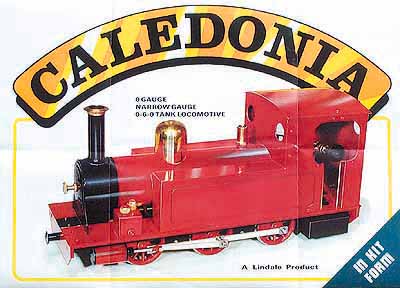
The unpainted, screw-together kit was well designed and the engine was a smooth, powerful runner. Initial kits suffered problems with the wheels falling off and the zinc-alloy siderods disintegrating. Due to these problems, perhaps, as well as some others, the company lasted but a very few years.
Upon Lindale's demise, Mr. Turner took over the design and began producing the locomotives built up, in a much more advanced form. He was a very slow builder, alas, so not many of his engines are around today. In addition to the Caledonia, he offered an 0-4-0 tender engine.
The two locomotives here are models of the same engine, but they differ in several ways. Both were acquired second hand. Caledonia is a gauge 0, alcohol-fired engine, while the enigmatically named Punsholt is gauge 1, gas fired.
Both engines share the same cylinder design and both are graced with a particularly good whistle, a very effective exhaust regulator, similar body work (which is far better and more detailed than the plain Lindale bodies), and John Turner's original valve gear, which he calls "a cross between Hackworth and Baker" and is not unlike that used by Koppel on their industrial engines. He wanted a valve gear that did not rely on a return crank, as he felt these would too easily get out of adjustment, so came up with his own. This gear has proven to be excellent. Water on both engines is admitted through a filler plug under the lift-off dome. Steam is also taken from beneath the dome. There is a displacement lubiricator near the smokebox of each engine, masquerading as a sand box.
The alcohol-fired engine is a pot boiler, evidenced by the charred paint around the front of the cab. It has a stainless-steel firebox that was influenced by the work of Jack Wheldon. The burner is pretty straightforward, except that there is no overflow pipe on the tank. Instead, there is the novel device of an easy-to-see sight glass on the side of the fuel tank.
The gas-fired engine has a sophisticated fuel system. The engine must be laid on its side for fuel filling (there was an fitting that allowed it to be filled while standing, but I have managed to mislay it). I had to make an adaptor to mate with the valve on the tank. Gas transfer is much quicker than on most other engines, even given this loco's large tank. In the cab is a diaphragm-type gas regulator and the delightful accessory of another pressure gauge. This one reads up to 15 psi and measures the pressure in the gas line. John Turner designed this as a low-velocity system that would enable him to use a larger jet in the burner. The result is a very controllable, quiet fire that needs no adjustment as the engine heats up. The pressure gauge lets you know just what's happening—a marvelous system!
The runs
We are in the middle of a splendid fall just now. The days are warm and the nights cool. Today was yet another bright, cloudless day—perfect for steaming.
I decided to run the meths fired, gauge-0 Caledonia first. Both these engine had been recently run, so I expected good performance. I wasn't disappointed. I filled the boiler with distilled water, the lubricator with steam oil, and I oiled the mechanism all around. I filled the fuel tank to the top of the glass and lit the fire in the usual way. Steam came up after about 10 minutes—a fairly long time. At about 40 psi, I opened the throttle in the cab, then opened the exhaust throttle on the smokebox front. The engine moved smoothly away. An interesting thing about Turner's engines (including the old Lindale locos) is that there never seemed to be any condensate in the cylinders. They were always ready to go. This may be because the entire engine gets very hot.
I coupled on three heavy coaches, which made no difference to the engine, but increased the audibility of the exhaust beat a little. It carried these around, lap after lap, for probably 40 minutes or so, with the occasional refilling of the meths tank. It was easy to throttle the engine down to a walk, which it would steadily maintain for as long as I wanted it to. This is particularly unusual with an engine with such large drivers. The run was near perfect.
Next, I prepared Punsholt. When all was ready, I opened the gas regulator until there was about 5 psi in the line, and lit the fire beneath the smokebox. The fire flashed back instantly. I increased the pressure to around 10 psi. Steam came up quickly, and within five minutes the engine was ready to go. I decreased the gas pressure a little and sent the engine on its way. I think the valves need a little attention, as the run, especially at slower speeds, was a little lumpy. That notwithstanding, the performance of the locomotive was excellent.
These are especially good engines. They perform superbly, are reasonably accurate scale models, and have some unique features. If one ever comes your way, grab it.
.
|
|
|
| Builder | John Turner (England) |
| Date built | Mid to late 1980s |
| Gauge | Nº 0 (32mm) and Nº 1 (45mm) |
| Scale | 16mm = 1' |
| Boilers | Pot (ga. 0) and single flue (ga. 1) |
| Fittings | Throttle, exhaust regulator, safety valve, pressure gauge, whistle, blowdown |
| Fuel | Alcohol (ga. 0) and butane (ga. 1) |
| Blow-off pressure | 50 psi |
| Cylinders | Two, double-acting D-valve |
| Reversing gear | Turner valve gear, controlled from cab |
| Lubricator | Displacement |
| Dimensions | Length, 12"; width, 4-1/8"; height, 6-3/4" |

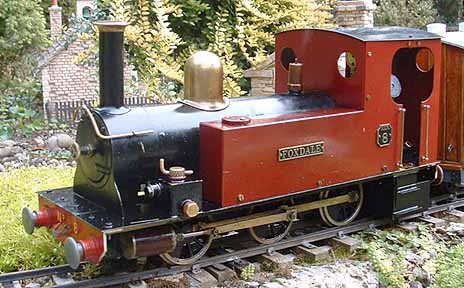
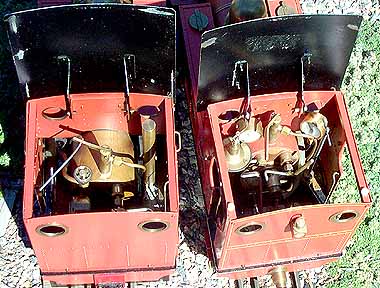

Above right: A closeup of the diaphragm-type gas regulator in Punsholt. In front of it is the whistle valve.
Right: The noses of both engines. The exhaust regulators are the wheels on the fronts of the smokeboxes.
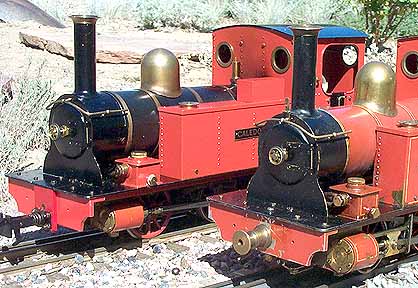

Left: The undersides of both locomotives. The firebox on the alcohol-fired loco (right) can clearly be seen. Only four small wicks power this engine. Note that the wheel-tread is wider on the gauge-1 engine than on the gauge-0 version. On both engines, fuel is stored beneath the cab. Extensive use is made of banjo fittings for steam connections.
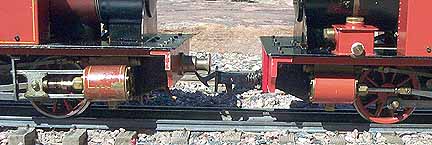
Back to Sidestreet Bannerworks home page
This page and its contents
Copyright Sidestreet Bannerworks, 2003